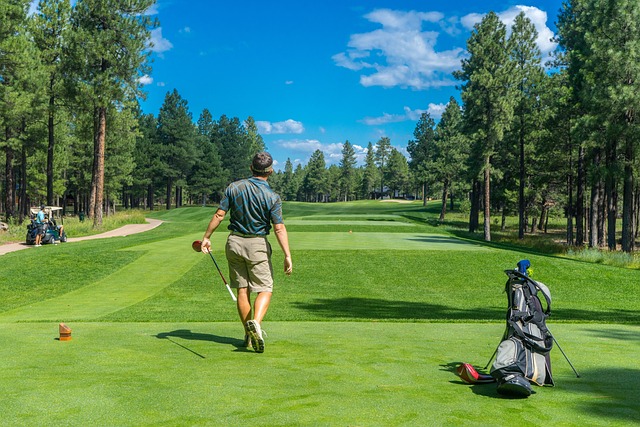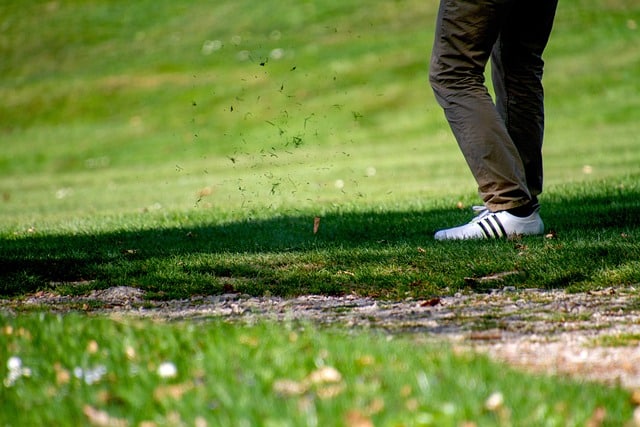Introduction – Grasses For Golf
We’ve talked about grasses for your yard but not so much grasses used on a golf course. In terms of carbon fixation trees are able to do a much better job because they extend upwards for any given surface. However, we still prefer that there’s greenery to dirt so we’re advocates of grass in whatever form, including for golf courses. Golf courses require specialized grass to maintain their carefully manicured appearance and provide a smooth playing surface. Golf grass, also known as turf grass, is bred for low height, wear and tear, and disease resistance. Different types of golf grass are suited for different climates and growing conditions.

Golf grass or “turfgrass” refers to the grass used on golf courses to create the lush, green playing surfaces we all know and love. Golf grass includes varieties like bermudagrass, bentgrass, and zoysiagrass, each with unique characteristics and benefits. Golf course superintendents choose and maintain a blend of different turfgrass varieties to produce consistent playing conditions year-round.
In addition to creating a beautiful aesthetic, golf grass plays an important function in regulating ball speed and keeping treacherous rough at bay. The next time you hit the links, take a moment to appreciate the hard work and careful planning that goes into creating those flawless fairways and greens. Without golf grass, the game simply wouldn’t be the same.
Types Of Golf Grass Found On Golf Courses
The best thing for golfers is to learn the different grass types out there and how they can potentially impact your game. Some of the most popular grass types are bermudagrass, bentgrass, and zoysiagrass. There are 6 types of golf grasses are there. Here are they:
Bermuda Grass
Bermuda grass is the most popular type used on a golf course. It is known for its low height, low wear and tear, and high disease resistance. Because of its ability to thrive in a wide range of climates and growing conditions, it is often the best choice for golf courses that need year-round playing surfaces. It can be mowed very short, making it ideal for putting greens, or allowed to grow longer for a more forgiving lie in the rough.
Bentgrass
Bentgrass is another popular choice for golf courses, as it is known for its fine texture and high tolerance to wear and tear. This grass can be grown at lower heights, making it suitable for precision-putting surfaces. However, bentgrass requires frequent mowing and specialized maintenance practices to maintain its health and appearance. The type of grass known as bentgrass is best for cooler temps and can last through the winter when another turf would die on a golf course.
Fescue Grass
Fescue grass is another type commonly used on golf courses for its resilience against disease, drought, and wear and tear. This type of turf can be grown at various heights to suit the needs of any course. While fescue can be relatively low-maintenance compared to other types of golf grass, it typically requires special care and maintenance practices to ensure high-quality playing conditions.
Zoysia grass
Zoysiagrass is a hardy type of turfgrass that thrives in warm climates with intense sunlight and little rainfall. It is known for its thick growth pattern and ability to tolerate heavy foot traffic without sustaining damage or wear. However, zoysiagrass also requires specialized care and maintenance practices to achieve optimal health.
Ryegrass
Ryegrass has an ideal growing temperature, so it’s often planted to fill in at golf courses for short periods. This grass is known for its quick growth and ability to withstand wear and tear. However, it typically requires specialized maintenance practices to achieve optimal health and appearance. The Ryegrass used on golf courses is mostly used on tee boxes and in the fairways.
Poa Grass
Poa grass is another popular choice for golf courses due to its ability to withstand harsh weather conditions and heavy foot traffic. This type of turf can be grown at various heights, making it very suitable for putting greens, fairways, and other high-traffic areas. However, Poa grass requires specialized maintenance practices to maintain its health and appearance.

Reasons For Using Golf Grass
There are several benefits to using golf grass. One of the primary benefits is improved performance. Golf grass is designed to hold up better to the wear and tear of the game, allowing golfers to play to their full potential. In addition, golf grass provides an enhanced appearance, with its lush, green look. Furthermore, golf grass is designed to provide improved foot comfort, with its softer surface than many other types of grass.
Maintenance Of Golf Grass
Golf grass requires regular maintenance in order to remain healthy and look its best. A key part of this is mowing, which should be done on a regular basis to maintain the desired height of the grass. Fertilizing can help to promote growth and health of the grass, while aeration helps to ensure that the roots of the grass get the oxygen they need. Finally, seeding can be done to encourage the growth of new grass and fill in any bare spots.
What Determines The Type Of Golf Course Grass That you Can use?
The type of grass used on a golf course is determined by several factors, including the climate and amount of sunlight in the area. Cool-season grasses, such as bentgrass and fescue, prefer cooler temperatures and do well in northern regions with cool summers and damp winters. Warm-season grasses, such as Bermuda and zoysia, thrive in hot climates with long summers and can tolerate drought better than cool-season grasses.
In addition to climate, maintenance practices also play a role in selecting the type of grass for a golf course. Some warm-season grasses require more frequent mowing and have a shorter playing season than cool-season varieties. The resources available for maintaining the course, including water usage and chemical treatments, may also play a role in determining the type of grass used on a golf course.
Overall, each golf course’s unique combination of climate and maintenance considerations will determine the type of grass used to create a lush fairway for players to enjoy.
What Is A Golf Green Called?
No single term is typically used to describe a golf green. Some common terms for this course section include putting green, fairway, and approach. Depending on the context, these terms may refer specifically to the grassy area or the entire course section where players putt or approach their shots. In general, however, most golfers use the term “green” when referring to this course section.
What Are The Names Of The Parts Of A Golf Course?
There are several different parts or sections of a typical golf course, each with unique characteristics and purposes. Some common components include these:
- tee box
- fairway
- rough
- green
- bunkers
- hazards
- putting surfaces
Each part of the course has different challenges for players and may require specialized maintenance practices to stay healthy and playable. Additionally, the layout of each part often varies depending on factors such as topography and weather conditions at the site. Overall, the various parts of a golf course work together to create an exciting and challenging playing experience for golfers.
Wrapping Up
Choosing the right type of grass for your golf course is a complex decision that considers many factors, including climate and growing conditions, playing style preferences and budget constraints. Whatever type of turfgrass you choose for your course, it is important to ensure that you provide the best conditions for healthy growth and high-quality performance. With careful planning and ongoing maintenance, your golf grass can help create the perfect playing experience for players of all skill levels.
